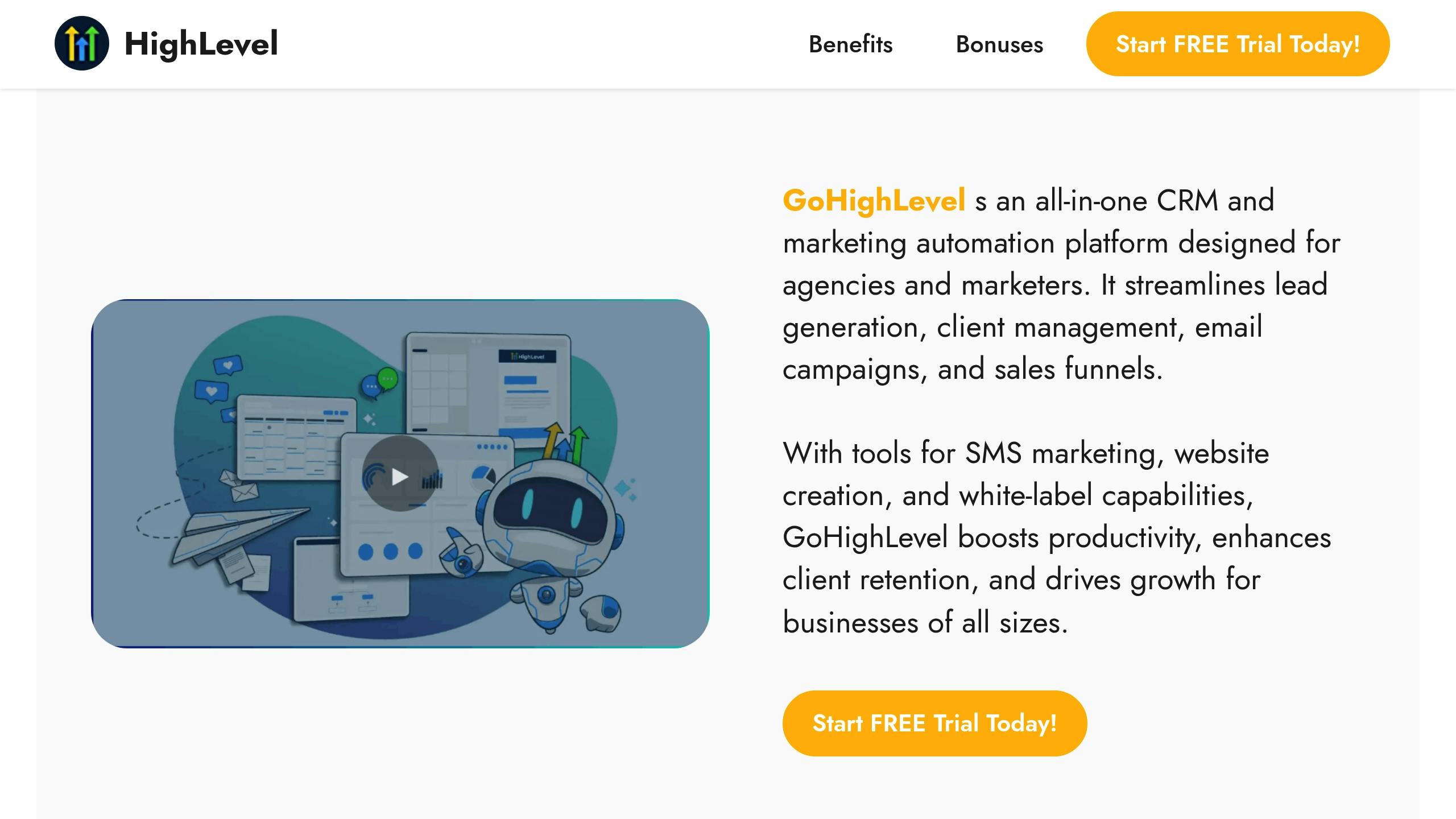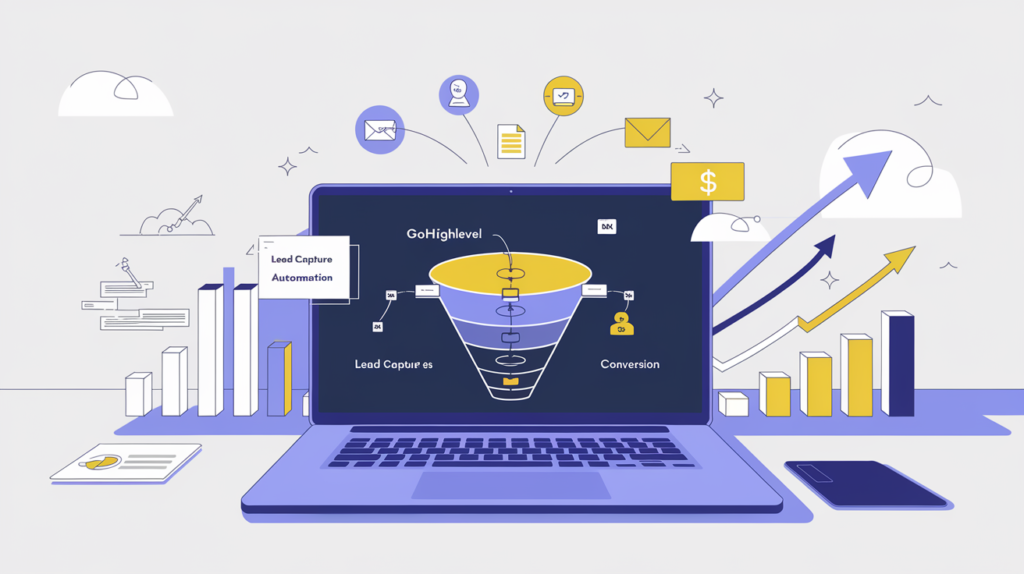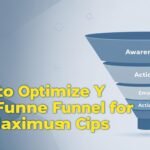A high-converting sales funnel is critical for turning leads into paying customers. Here’s a quick breakdown of how to build one using GoHighLevel:
- Define Your Goals and Audience: Set measurable objectives like lead generation or sales conversions. Use GoHighLevel’s tools to segment and analyze your target audience.
- Choose a Funnel Template: Pick a pre-built template from GoHighLevel’s library and customize it with your branding.
- Create Landing Pages: Design pages with clear headlines, forms, and CTAs. Optimize for mobile devices.
- Develop Lead Magnets: Offer valuable resources like templates, eBooks, or free trials to capture leads.
- Set Up Email and SMS Follow-Ups: Use automation to send personalized messages and nurture leads.
- Test and Improve: Track metrics like opt-in rates and sales. Use A/B testing to refine your funnel.
Key Metrics to Track:
- Opt-in Rate: Measures lead capture effectiveness.
- Sales Conversion Rate: Tracks how many leads turn into customers.
- Response Time: Ensure follow-ups are sent within 5 minutes.
By following these steps and leveraging GoHighLevel’s automation and analytics, you can create a streamlined funnel that boosts conversions and reduces manual effort.
How to Set Up a Sales Funnel in GoHighLevel (Step-by-Step Guide)

Step 1: Set Your Funnel Purpose and Target Market
Defining the purpose of your sales funnel and understanding your audience is the first step to success. GoHighLevel’s analytics tools make it easier to set clear objectives and analyze your target market’s behavior.
Define Measurable Goals
With GoHighLevel’s dashboards, you can track key metrics in real time, ensuring your goals remain actionable and measurable.
Here’s how you can structure your goals:
| Goal Type | Example Metric | Tracking Method |
|---|---|---|
| Lead Generation | 500 qualified leads/month | Lead capture forms, conversion tracking |
| Sales Conversion | 25% lead-to-sale rate | Pipeline stage progression |
| Customer Value | $2,500 average deal size | Revenue tracking per customer |
| Response Time | < 5 minutes follow-up | Automation workflow metrics |
Map Out Your Target Audience
GoHighLevel’s segmentation tools allow you to create detailed customer profiles based on behavior and engagement data. This ensures you can customize your funnel content for different audience groups.
Key areas to focus on:
- Demographic Profiling: Use GoHighLevel’s CRM to gather and analyze data like:
- Age, location
- Industry and job roles
- Company size and revenue
- Purchase history and preferences
- Behavioral Tracking: Dive into how prospects interact with your content using GoHighLevel’s analytics, such as:
- Email open rates and click patterns
- Website navigation paths
- Content engagement metrics
- Timing of purchase decisions
- Engagement Scoring: Set up GoHighLevel’s lead scoring system to:
- Track the frequency of interactions
- Measure content consumption
- Monitor social media engagement
- Assess purchase readiness
Regularly review this data on GoHighLevel’s dashboard to fine-tune your targeting. The platform’s real-time analytics let you see which audience segments are most responsive at various funnel stages [1].
By using GoHighLevel’s automation tools, you can send personalized content tailored to each segment. This approach ensures your prospects receive the right information at the right time, boosting your chances of conversion [2].
Now that you’ve established your audience and goals, you’re ready to choose the best funnel template in Step 2.
Step 2: Pick and Modify Your Funnel Template
Browse GoHighLevel Templates
GoHighLevel offers a library of pre-built funnel templates designed for various industries and goals. To access these, navigate to Sites > Funnels and click “+ New Funnel.” Templates are organized by industry and purpose, making it simple to find one that suits your needs.
Here’s a quick look at some industry-specific templates and their features:
| Industry | Template Features | Core Elements |
|---|---|---|
| Car Wash | • 3-tier pricing packages • Service listings • Appointment booking |
Client testimonials, pricing tables, booking calendar |
| Automotive | • Service price list • Work portfolio • Location map |
Team profiles, service gallery, online scheduling |
| Used Cars | • Vehicle showcase • FAQ section • Appointment calendar |
Inventory display, testimonials, contact forms |
Before selecting a template, use the preview option (click the eye icon) to ensure it aligns with your funnel’s purpose. Once you’ve chosen, move on to customizing it for your brand.
Adjust Templates to Match Your Brand
Once you’ve picked a template, GoHighLevel’s drag-and-drop editor makes customization easy. Modify the template to meet the goals and audience preferences you identified in Step 1.
- Visual Branding Elements
Update logos, images, colors, fonts, and other visual assets to match your brand identity. Adjust button styles and incorporate any necessary graphics or videos. - Content Personalization
Tailor the text to highlight your unique value proposition:- Rewrite headlines and body text to reflect your brand’s voice.
- Use personalized merge tags for dynamic content.
- Add testimonials and social proof that resonate with your audience.
- Mobile Optimization
Preview the funnel on both desktop and mobile devices. Ensure readability, adjust spacing, and confirm that buttons and forms are easy to interact with.
Step 3: Build Converting Landing Pages
Must-Have Landing Page Elements
Create high-performing pages using GoHighLevel’s Site Builder, which organizes your content into sections, rows, and columns [3].
Key elements to include:
- Headlines: Use action-driven text to clearly communicate your value proposition with GoHighLevel’s editor.
- Forms: Place lead capture forms prominently above the fold and customize fields and styles to suit your needs [5].
- CTAs (Call-to-Actions): Make buttons stand out with persuasive text and contrasting colors, as demonstrated by Klientboost [4].
Here’s a quick breakdown of essential landing page sections and their purposes:
| Section | Purpose | Key Elements |
|---|---|---|
| Hero Area | Grab attention instantly | Headline, subheadline, primary CTA |
| Value Proposition | Highlight benefits | Features, benefits, social proof |
| Social Proof | Build trust | Testimonials, case studies, logos |
| Lead Magnet | Collect user info | Form, offer details, privacy notice |
Once your landing page is set up, make sure it works seamlessly on mobile devices.
Make Pages Mobile-Ready
Mobile optimization is critical for boosting conversions. GoHighLevel offers tools to help ensure your pages perform well on smaller screens.
Steps to optimize for mobile:
- Use the mobile view editor to fine-tune font sizes, button dimensions, and spacing.
- Eliminate unnecessary links to keep the focus on conversions.
- Test your page on different devices to ensure it looks and functions as intended.
Freeman‘s landing page strategy is a great example of this. They place CTA buttons at the top of their mobile pages, ensuring they’re immediately visible [4].
sbb-itb-1c6633a
Step 4: Create Lead Magnets That Work
To improve your funnel’s performance, focus on crafting lead magnets that draw in and engage your target audience. Research shows that 17% of content marketers rank gated content as a top performer [6].
Choose the Right Lead Magnet
The best lead magnets solve specific problems and provide immediate benefits to your audience. Segmented emails, for instance, have been shown to boost open rates by 30% and click-through rates by 50% [6].
Here are some popular lead magnet types with real-world examples:
| Lead Magnet Type | Best Use Case | Example of Success |
|---|---|---|
| Interactive Tools | Technical Assessment | WordStream‘s Google Ads Performance Grader |
| Educational Content | Industry Knowledge | Hotjar‘s customer delight ebook |
| Templates/Resources | Immediate Application | Todoist‘s productivity templates |
| Free Trials/Demos | Product Showcase | Semrush‘s 7-day trial |
Once you’ve nailed down your lead magnet idea, the next step is to ensure you’re capturing leads effectively.
Tips for Creating Effective Lead Magnets in GoHighLevel
- Understand Your Audience
Dive into your target market’s preferences and challenges. Use tools like quizzes to create personalized experiences. - Offer Real Solutions
Make sure your lead magnet addresses a specific pain point or need.
“A lead magnet compels your site visitors to exchange information, such as their email address for access. This can be a piece of content such as a whitepaper, ebook, or newsletter.” [7]
Set Up Lead Capture Forms
Once your lead magnet is ready, you need a simple and effective way to collect information.
- Design a User-Friendly Form
- Open the Form Builder under the Marketing tab.
- Start from scratch or use a pre-made template.
- Use the drag-and-drop feature to add only essential fields [9].
- Make Your Form Conversion-Friendly
- Keep it short – request only the most important details.
- Use conditional logic to display fields based on user input.
- Set up automated follow-ups using GoHighLevel’s workflow system [9].
Customize the form’s look under the Styles tab and set it to Full Width for better responsiveness. Always test your forms on different devices to ensure they work seamlessly [10].
“Helping, not selling – this is the goal of the best lead magnets. In any case, there’ll be plenty of opportunities to sell later.” [8]
Incorporate these forms into your workflow to streamline your lead collection process.
Step 5: Set Up Email and SMS Follow-ups
Once you’ve gathered leads, the next step is to nurture them with effective follow-up communication. Did you know that 80% of sales require at least five follow-ups? [13]
Write Clear Follow-up Messages
Your follow-up messages should provide value and encourage engagement. Here’s a simple guide to structuring these messages in GoHighLevel:
| Message Type | Best Timing | Key Components |
|---|---|---|
| Welcome Email | Immediate | Introduction, next steps, clear value offered |
| SMS Confirmation | Within 5 minutes | Brief acknowledgment, clear call-to-action |
| Educational Content | 24–48 hours | Helpful insights, resource links |
| Sales Offer | 3–5 days | Specific offer, urgency to act |
Start by creating message templates in the Marketing section of GoHighLevel [16]. Research shows that sending a text follow-up shortly after initial contact can boost engagement and conversion rates by 112% [14].
Key tips for effective follow-ups:
- Use merge tags to personalize messages.
- Keep SMS messages short and to the point.
- Include a single, clear call-to-action.
- Maintain a professional tone throughout.
- Offer immediate value to the recipient.
When combined with automated workflows, these templates can save time and improve results.
Build Message Automation Rules
To automate your follow-ups, head to the Automate tab in GoHighLevel [12]. Here’s how to get started:
- Create Trigger-Based Workflows
Set up workflows triggered by specific events, like form submissions or appointment bookings. For example:- Send a confirmation email immediately after a lead books an appointment.
- Schedule an SMS reminder 24 hours before the appointment.
- Follow up with an email two hours after the meeting [12].
- Use Conditional Logic
Add if/else conditions to customize follow-ups based on how leads interact with your messages [15]. - Adjust Timing
Space out your messages with delay steps to avoid overwhelming your leads [12].
Testing Your Automation: Always test your workflows with a sample contact. Check for proper delays, personalization, and trigger accuracy. Monitor delivery rates to ensure everything runs smoothly.
Step 6: Test and Improve Your Funnel
Track Key Metrics
GoHighLevel’s Sites Analytics dashboard, found under Sites > Analytics, offers detailed insights into your funnel’s performance [17]. Use it to track key indicators that show how well your funnel is working.
Here are the key metrics to keep an eye on:
| Metric | What to Track | Why It Matters |
|---|---|---|
| Page Views | Total vs. Unique views | Understand overall traffic and repeat visits |
| Opt-in Rate | (Opt-ins × 100) / Unique views | Measure how effective your lead capture is |
| Sales Rate | (Sales × 100) / Unique views | Gauge how well your funnel converts leads |
| Earnings/View | Revenue / Unique views | Assess revenue efficiency per visitor |
The dashboard even calculates percentage changes compared to past periods, making it easier to spot trends. For instance, if your opt-in rate dips from 25% to 20%, it may signal the need to tweak your lead magnets or adjust form placement.
Pro tip: Use GoHighLevel to set specific conversion goals, such as form submissions, phone inquiries, or product purchases [18]. These goals will help you zero in on actionable insights and refine your funnel more effectively.
Test Different Funnel Elements
A/B testing in GoHighLevel is a powerful way to improve your funnel by making data-backed decisions. Here’s how to do it:
- Set Clear Objectives
Define specific goals for each test and focus on one element at a time. For example, test the headline or call-to-action (CTA) button – but not both at once – to get clear results [19]. - Create Variations
Once your domain is added to the funnel [11], set up test variations. Here are some ideas:- Headlines: Try different value propositions.
- CTAs: Experiment with button colors, text, or placement.
- Forms: Adjust the number of fields or layout.
- Images: Test various visuals to see what resonates.
- Monitor Results
GoHighLevel uses browser cookies to track split test performance [11]. Use the analytics tools to measure:- Conversion rates for each variation
- User engagement metrics
- Time spent on the page
- Form completion rates
Make sure to run tests long enough to gather statistically significant data. Avoid changing the control version during the testing period [11].
“We are thrilled to announce the launch of our new Sites Analytics dashboard, which will empower you with actionable insights into website and funnel performance.” – HighLevel Support Portal [17]
When testing, focus on elements that often have the biggest impact on conversions, such as:
- Landing page headlines
- Call-to-action buttons
- Lead magnet designs
- Checkout page layouts [20]
Conclusion: Start Building Your Sales Funnel
Get your funnel up and running quickly with GoHighLevel’s tools and templates, then fine-tune it through regular testing. The best funnels are built and improved over time. With GoHighLevel’s analytics dashboard, you can track your funnel’s performance and make adjustments as needed.
Here’s a quick breakdown of the funnel-building process:
| Phase | Action | Expected Outcome |
|---|---|---|
| Planning | Define your funnel goal and audience | A clear strategy to guide your funnel |
| Setup | Use GoHighLevel templates | A solid starting point with proven design |
| Launch | Add automation workflows | Smooth lead nurturing |
| Optimize | Analyze data and run A/B tests | Better conversion rates |
GoHighLevel offers features to support every step of this process. With any paid plan, you can create unlimited funnels, websites, and workflows [21]. Follow these steps to move efficiently from planning to launching.
Key elements for success include:
- Strong calls-to-action that drive engagement
- Social proof to establish trust
- Email and SMS follow-ups to maintain connections
Use GoHighLevel’s drag-and-drop editor and real-time analytics to adjust your funnel based on performance insights. Pick a template, tweak it to fit your brand, and launch your funnel today.


